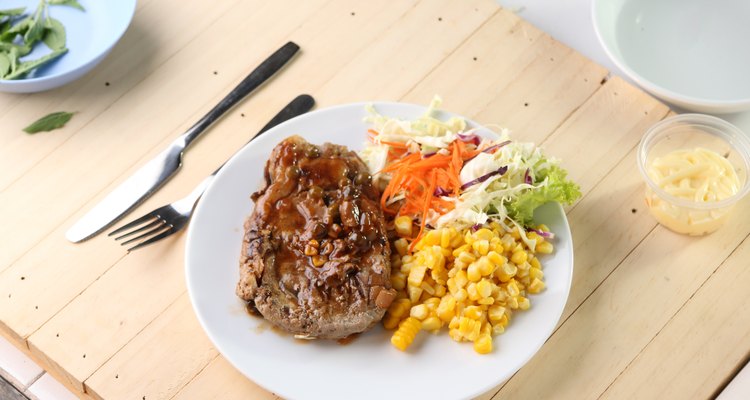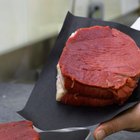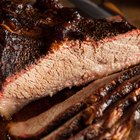
ko_orn/iStock/Getty Images
Humans have been hunting and eating meat for the past 2.5 million years. Until the advent animal domestication around 6500 B.C., meat was an occasional source of protein that depended upon the luck and skill of the hunter. While meat is more readily available these days, certain cooking practices can help you derive the most protein from your food budget.
Protein Content
The nutrient content of certain cuts may vary somewhat; however, most steak is made up of approximately 21 percent protein, 72 percent water and 6 percent fat. Other animal protein sources, such as chicken, lamb and salmon, are similar in their proportions of these nutrients. Notable exceptions include pork, which has a higher average fat content of 10 percent, and cod, which contains 1 percent fat. Steak and other animal protein sources also contain up to 2 percent minerals and sugars.
Denaturation
Cooking changes the structure of protein molecules, causing them to break apart, unravel and condense in a process known as denaturation. Denaturation does not alter the protein value of steak, because your digestive system breaks all of your dietary proteins, whether from animal or plant sources, denatured or undenatured, into their component amino acids before they can be absorbed into your bloodstream. However, burning or charring steak renders the proteins in the blackened parts unusable and decreases the available protein content of the meat.
Myoglobin
The water component of steak is a valuable potential protein source due to its large quantities of a type of protein called myoglobin, according to the website AmazingRibs.com. Cooking methods such as stews, soups and meat pies, which retain the fluid portion, will provide the highest protein content, while myoglobin drips off and is largely lost in the cooking process when you grill, fry or broil meat. Cooking to a rare or medium-rare is a protein-sparing compromise if grilling, frying or broiling are your only options. However, careful attention to proper storage, cooking and serving temperatures becomes increasingly important the less well-done you prepare your steak.
Considerations
Avoid food-borne illness by following safe storage and cooking practices to prevent bacterial overgrowth. Keep steak refrigerated at temperatures between 34 and 39 degrees Fahrenheit, which inhibits microbe growth while keeping your steak fresh and unfrozen. When cooked, the inside of your steak should exceed 140 degrees Fahrenheit -- the temperature range in which bacterial growth is most rapid. Do not allow steak to cool to less than 130 degrees Fahrenheit before serving.
Related Articles

How to Cook London Broil

How to Grill a Lamb Steak

Why Do Pork Chops Turn White?

How Long Should Steaks Rest After ...

The Difference Between Grilled & ...

How to Cook Grunt Fish
How to Cook Buffalo Fillet

How to Cook Kobe Steaks

What Is a Rib-Eye Steak?

How to Cook a Beef Roast in a Roaster ...

How to Get Skirt Steak Tender

How to Sear Ribs

How to Slice Round Steak for Jerky

How to Grill a Ribeye on a Weber Q
How to Slow Cook a Top Sirloin Round ...

How to Cook a Large Amount of Corned ...

Can Lamb Chops Be Pink in the Middle?

How Much Does Meat Shrink After It Is ...

How to Steam a Brisket of Beef

How to Cook Duck Fillets
References
Writer Bio
Tracey Roizman, DC is a writer and speaker on natural and preventive health care and a practicing chiropractor. She also holds a B.S. in nutritional biochemistry.
Photo Credits
ko_orn/iStock/Getty Images